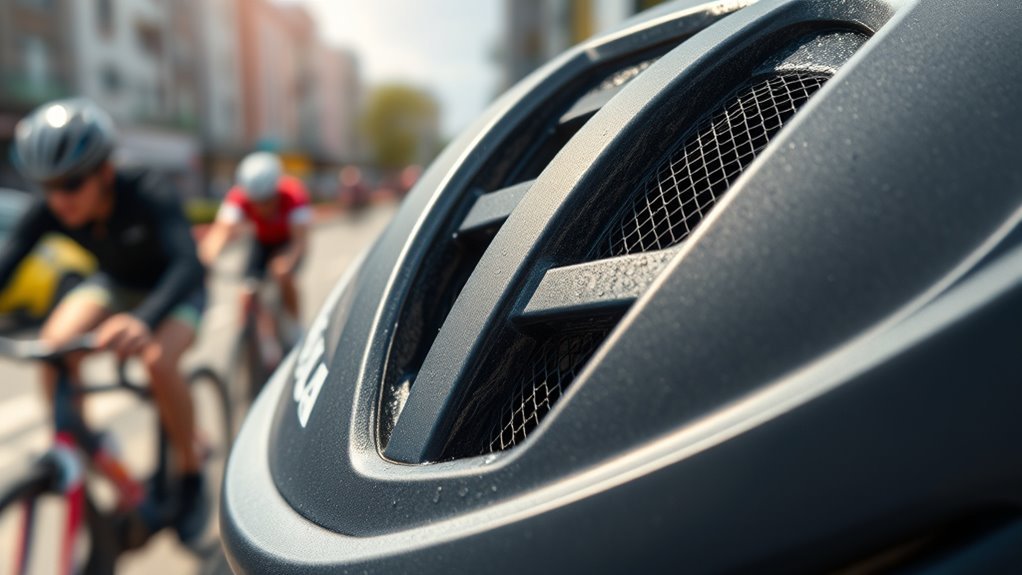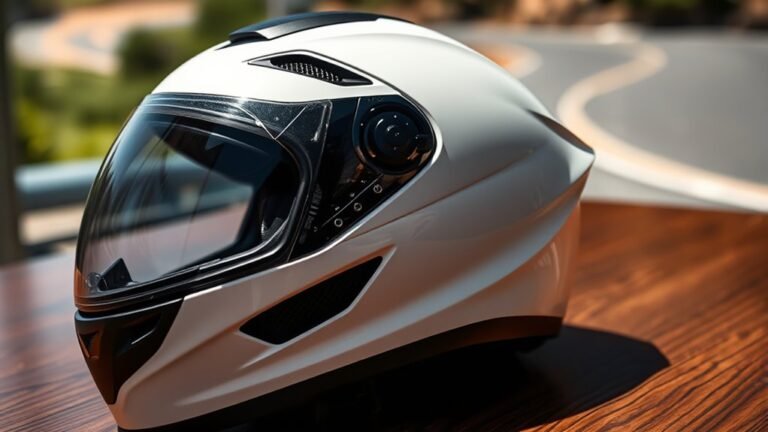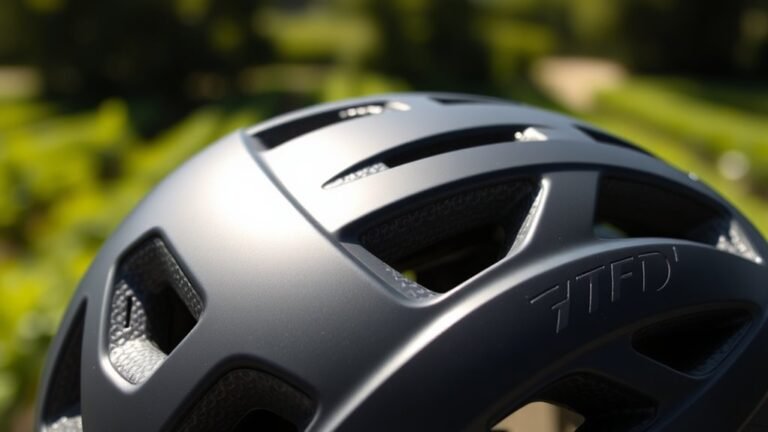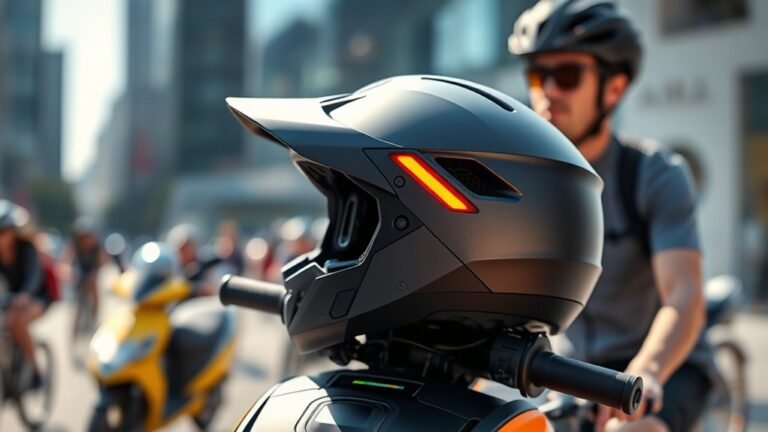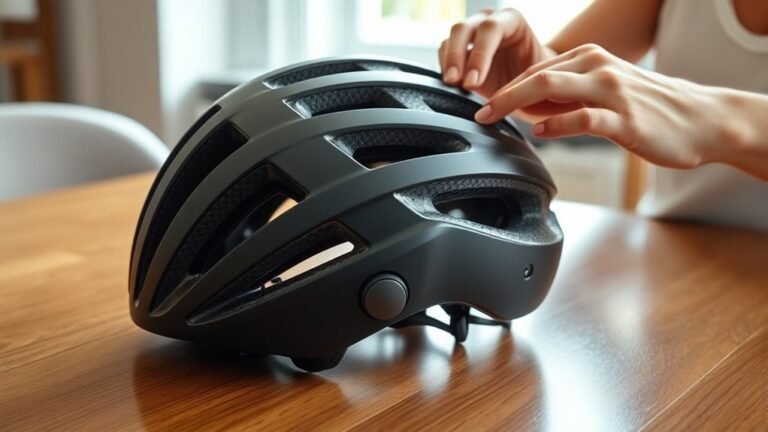The Importance of Ventilation in Urban Helmets
Ventilation in urban helmets is essential for your comfort and safety. Effective airflow prevents overheating, which can impair cognitive functions and reaction times, making it critical for safe riding. Well-ventilated helmets reduce heat and moisture buildup, improving overall health and freshness. Innovations like adjustable vents and active materials enhance airflow according to conditions. Choosing a helmet with ideal ventilation can greatly influence your riding experience. Discover how these features can enhance your comfort further.
The Role of Airflow in Helmet Design

While you might not think about it at first, airflow plays an essential role in helmet design, greatly influencing comfort and safety. Understanding airflow dynamics is vital; it guarantees that heat and moisture are effectively managed during rides. Designers consider various factors, such as ventilation placement and channeling, to optimize airflow without compromising structural integrity. For instance, strategically positioned vents can enhance cooling while maintaining aerodynamic efficiency. Additionally, the materials used can affect how air moves within the helmet. By prioritizing these design considerations, manufacturers can create helmets that not only protect but also allow riders to feel more comfortable and free during their journeys. Ultimately, effective airflow is a key component that contributes to a better riding experience.
Health Benefits of Proper Ventilation
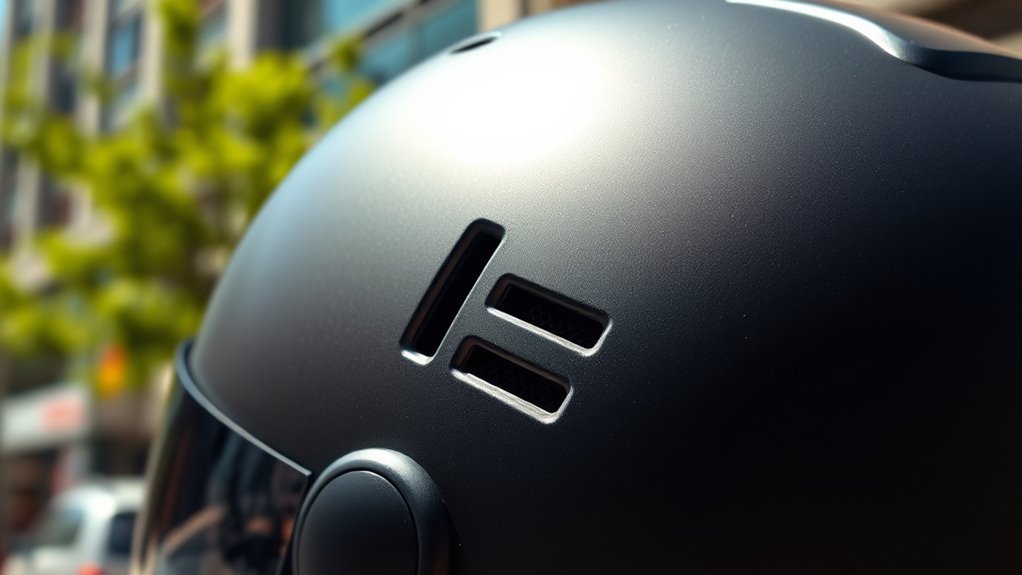
Proper ventilation in urban helmets is essential not only for comfort but also for your overall health during rides. Insufficient airflow can lead to a buildup of heat and moisture, increasing discomfort factors that distract you from the road. This uncomfortable environment can elevate stress levels, contributing to health risks like heat exhaustion. Additionally, stagnant air can trap pollutants, exposing you to harmful particles that compromise respiratory health. A well-ventilated helmet promotes airflow, helping to regulate temperature and maintain a fresh atmosphere inside. By prioritizing proper ventilation, you not only enhance your comfort but also safeguard your well-being, empowering you to enjoy your ride with peace of mind. Freedom on the road starts with a helmet that supports your health.
Impact of Temperature Regulation on Performance

Maintaining ideal temperature regulation within an urban helmet directly influences your riding performance. When temperatures rise, your body may struggle to stay cool, leading to fatigue and decreased focus. Research shows that temperature effects, such as overheating, can impair cognitive functions and reaction times, ultimately hindering your ability to navigate urban environments safely. Conversely, a well-ventilated helmet promotes airflow, allowing heat to dissipate and maintaining comfort. This performance enhancement not only keeps you alert but also enhances your overall riding experience. For those who cherish the freedom of the open road, understanding the role of temperature regulation is vital. Investing in a helmet designed with effective ventilation can make the difference between a thrilling ride and a distracting one.
Types of Ventilation Systems in Urban Helmets
Ventilation systems in urban helmets play an essential role in enhancing rider comfort and safety. There are two primary types of ventilation systems: passive ventilation and active ventilation. Passive ventilation relies on strategic airflow pathways, allowing natural air to circulate through the helmet. This design helps dissipate heat without requiring any additional energy, making it efficient and lightweight. On the other hand, active ventilation systems utilize fans or vents that can be adjusted based on your preferences or riding conditions. This provides a more controlled airflow and can greatly reduce humidity inside the helmet. By understanding these systems, you can choose a helmet that best fits your needs, ensuring a comfortable ride while maintaining safety on urban roads.
How Ventilation Affects Rider Comfort
While riding in an urban environment, the quality of airflow within your helmet can considerably influence your overall comfort. Proper ventilation directly impacts your rider experience by regulating temperature and moisture levels. Helmets designed with effective comfort features, like well-placed vents, allow fresh air to circulate while dissipating heat generated during your ride. This prevents that stifling feeling that can distract you from the freedom of the open road. Studies show that riders with well-ventilated helmets report higher satisfaction levels, as they can focus on their journey rather than discomfort. Ultimately, the right ventilation system not only enhances your enjoyment but also promotes longer rides without fatigue, letting you fully embrace urban adventures.
The Connection Between Ventilation and Safety
Effective ventilation in urban helmets plays a critical role in safety by facilitating heat dissipation, which can greatly reduce the risk of overheating during rides. When you’re comfortable and your core temperature is regulated, your visibility and focus improve, minimizing distractions that could lead to accidents. Additionally, enhanced airflow helps combat fatigue, allowing you to stay alert and responsive to your surroundings.
Heat Dissipation Mechanism
When temperatures rise, the ability of urban helmets to dissipate heat becomes essential for both comfort and safety. Effective heat transfer relies on airflow dynamics that facilitate cooling. When your helmet allows for ideal ventilation, it reduces the risk of overheating, enhancing your overall riding experience.
- You can feel the breeze, not just the heat.
- A cooler head means sharper focus and better decisions.
- Staying comfortable helps you enjoy your ride, not dread it.
- Your safety isn’t just about protection; it’s about feeling free.
Impact on Visibility
How does proper ventilation influence your visibility while riding? Effective ventilation in urban helmets plays an essential role in addressing visibility challenges. When airflow is optimized, it helps prevent fogging and condensation inside the helmet, ensuring you maintain a clear line of sight. This clarity is vital for spotting obstacles and maneuvering busy streets safely.
| Visibility Challenges | Visibility Enhancements |
|---|---|
| Fogged visor | Increased airflow |
| Heat-induced distortion | Clearer peripheral vision |
| Sweat accumulation | Consistent visibility |
| Restricted sightlines | Enhanced focus on surroundings |
Ultimately, a well-ventilated helmet not only keeps you comfortable but also greatly boosts your safety by enhancing your visibility. Don’t compromise on your freedom—choose a helmet that prioritizes ventilation!
Minimizing Fatigue Levels
While visibility is paramount for urban riders, minimizing fatigue levels is equally important for maintaining safety on the road. Effective ventilation in helmets plays an essential role in fatigue reduction and endurance enhancement. When you’re comfortable and cool, you’re less likely to feel drained, allowing you to focus on the ride ahead.
- A clear mind enhances decision-making.
- Reduced heat means longer rides without discomfort.
- Staying alert reduces the risk of accidents.
- Increased comfort fosters a sense of freedom.
Choosing a well-ventilated helmet isn’t just about style; it’s about your ability to ride confidently and safely. Prioritizing ventilation guarantees you enjoy the journey while minimizing fatigue, ultimately empowering you to embrace the open road.
Innovations in Helmet Ventilation Technology
As urban environments continue to evolve, innovations in helmet ventilation technology have become essential for enhancing rider safety and comfort. Today’s helmets incorporate active materials that respond to temperature changes, allowing for better airflow when conditions get hot. This dynamic approach guarantees that you stay cool without sacrificing protection. Additionally, adjustable vents have become a game-changer. They let you customize airflow based on your ride, whether you’re cruising through city streets or tackling steep hills. Research shows that optimized ventilation can considerably reduce sweat buildup, enhancing focus and comfort on your journey. By embracing these advancements, you’re not just protecting your head; you’re also guaranteeing a more enjoyable, liberated riding experience in the urban landscape.
Choosing the Right Helmet for Urban Riding
Selecting the right helmet for urban riding is essential not only for safety but also for comfort and performance on the road. You’ll want to take into account various helmet features that enhance your riding experience while guaranteeing safety. Here’s what you should prioritize:
- Ventilation: Keeps you cool during long rides.
- Lightweight Design: Reduces fatigue on daily commutes.
- Adjustable Fit: Ensures a snug, secure feel.
- Reflective Elements: Enhances visibility in city traffic.
Maintenance Tips for Optimal Ventilation
To guarantee your helmet’s ventilation system functions effectively, regular maintenance is essential. Neglecting this can hinder airflow, affecting your comfort and safety. Implement these cleaning protocols to assure ideal ventilation maintenance:
| Task | Frequency | Tools Needed |
|---|---|---|
| Inspect vents | Monthly | Soft brush, cloth |
| Clean interior lining | Bi-weekly | Mild detergent, water |
| Check for blockages | Before every ride | Compressed air |
Future Trends in Helmet Ventilation Design
While many traditional helmet designs have focused primarily on safety, the future of helmet ventilation is shifting towards innovative technologies that enhance airflow without compromising protection. You’ll see designs prioritizing aerodynamic efficiency and environmental adaptability, ensuring comfort in varying conditions.
The future of helmets blends safety with innovative ventilation, ensuring comfort and adaptability for every ride.
- Breathable materials that regulate temperature
- Smart ventilation systems that adjust to activity levels
- Lightweight structures that don’t sacrifice protection
- Aesthetic designs that reflect personal style
These trends not only promote freedom of movement but also encourage you to enjoy your ride, knowing that your helmet supports both safety and comfort. As urban environments evolve, embracing these advancements will allow you to navigate your world with confidence and ease.
Frequently Asked Questions
Can Helmet Ventilation Reduce Fogging on Eyewear?
Yes, helmet ventilation can greatly reduce fogging on eyewear. When airflow improves, moisture is less likely to accumulate on lenses, enhancing eyewear comfort. Studies show that well-ventilated helmets allow heat and humidity to escape, which directly contributes to fog reduction. So, if you’re looking to enjoy a clearer view while riding, investing in a helmet with effective ventilation can provide both safety and an unobstructed line of sight for your adventures.
What Materials Enhance Helmet Ventilation Effectiveness?
To enhance helmet ventilation effectiveness, you should consider mesh materials and strategically designed air channels. Mesh materials allow for better airflow while maintaining structural integrity, promoting breathability without compromising protection. Air channels, on the other hand, facilitate the movement of air, reducing heat buildup. When combined, these elements create a comfortable environment, helping you stay cool and focused during your ride, ultimately giving you the freedom to enjoy your urban adventures.
How Often Should I Replace My Helmet for Optimal Ventilation?
You should replace your helmet every 3 to 5 years for ideal ventilation benefits. Picture the hot sun beating down as you ride; a well-ventilated helmet can feel like a revitalizing breeze. Over time, materials degrade, reducing not just protection but also airflow. An expired helmet loses its effectiveness, compromising your safety and comfort. Regularly replacing your helmet guarantees you’re always riding freely, enjoying that rush without worrying about inadequate ventilation or protection.
Do Different Riding Styles Require Different Ventilation Designs?
Yes, different riding styles do require different ventilation designs. For road biking, helmets often feature streamlined vents to reduce drag while maximizing airflow for long rides. In contrast, mountain biking helmets tend to have larger, more aggressive vents to handle varying terrain and increased sweat during climbs. Understanding these differences guarantees you choose a helmet that not only keeps you cool but also enhances your performance, allowing you the freedom to ride without discomfort.
Are There Ventilation Options for Specific Weather Conditions?
Choosing a helmet’s ventilation is like selecting the right gear for a journey through changing seasons. There are indeed ventilation options tailored for specific weather conditions, incorporating climate considerations and weather adaptations. For instance, helmets with adjustable vents allow for increased airflow on hot days, while those with minimal openings provide warmth during colder rides. Understanding these features guarantees you stay comfortable and free, no matter the weather conditions you face.
